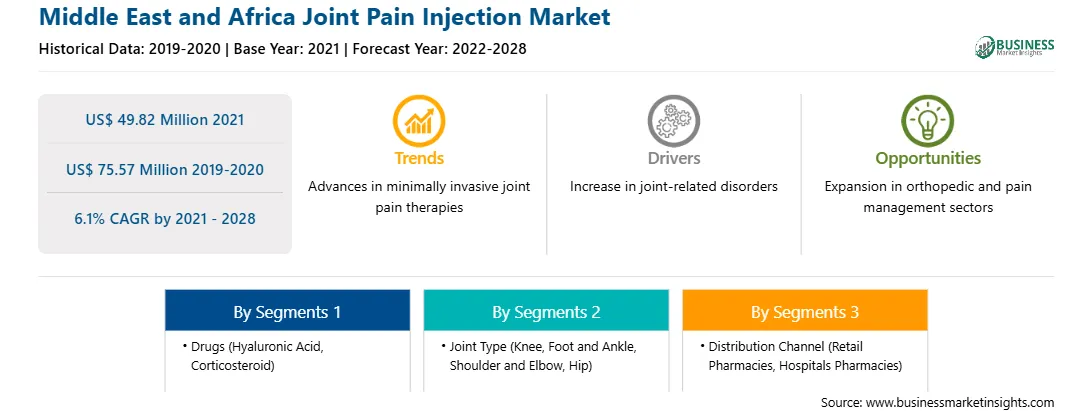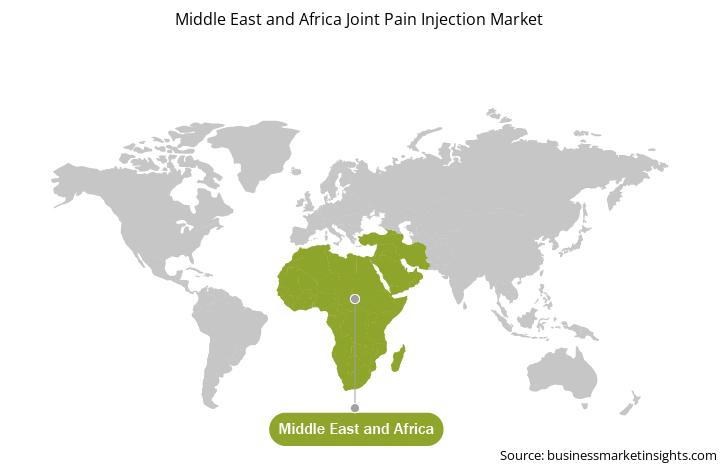The Middle East and Africa joint pain injection market is
Several Middle Eastern and African countries witnessed an unprecedented rise in the number of COVID-19 cases which led to the discontinuation of several business operations and manufacturing activities of various healthcare products, including joint pain injections, which negatively impacted the joint pain injection market during the early months of 2020. Shortage of hospital supplies also accelerate the criticality of the condition. During the pandemic, the focus of healthcare professionals was only limited to the covid management, which substantially hampered the number of elective surgeries in the region. Moreover, implementation of social distancing policies resulted into limited patients visits to orthopedic centers, which drastically impacted the demand and adoption of joint pain injections in Middle East and Africa. Apart from this, a huge population already face a growing burden of non-communicable diseases, making them more vulnerable to the virus. Moreover, economic uncertainties and ongoing conflicts are worsening the condition in the region.

Strategic insights for the Middle East and Africa Joint Pain Injection provides data-driven analysis of the industry landscape, including current trends, key players, and regional nuances. These insights offer actionable recommendations, enabling readers to differentiate themselves from competitors by identifying untapped segments or developing unique value propositions. Leveraging data analytics, these insights help industry players anticipate the market shifts, whether investors, manufacturers, or other stakeholders. A future-oriented perspective is essential, helping stakeholders anticipate market shifts and position themselves for long-term success in this dynamic region. Ultimately, effective strategic insights empower readers to make informed decisions that drive profitability and achieve their business objectives within the market.

| Report Attribute | Details |
|---|---|
| Market size in 2021 | US$ 49.82 Million |
| Market Size by 2028 | US$ 75.57 Million |
| CAGR (2021 - 2028) | 6.1% |
| Historical Data | 2019-2020 |
| Forecast period | 2022-2028 |
| Segments Covered |
By Drugs
|
| Regions and Countries Covered | Middle East and Africa
|
| Market leaders and key company profiles |
|
The geographic scope of the Middle East and Africa Joint Pain Injection refers to the specific areas in which a business operates and competes. Understanding local distinctions, such as diverse consumer preferences (e.g., demand for specific plug types or battery backup durations), varying economic conditions, and regulatory environments, is crucial for tailoring strategies to specific markets. Businesses can expand their reach by identifying underserved areas or adapting their offerings to meet local demands. A clear market focus allows for more effective resource allocation, targeted marketing campaigns, and better positioning against local competitors, ultimately driving growth in those targeted areas.

The joint pain injection market in Middle East and Africa is expected to grow from US$ 49.82 million in 2021 to US$ 75.57 million by 2028; it is estimated to grow at a CAGR of 6.1% from 2021 to 2028. Countries in Middle East and Africa are emerging as attractive outsourcing locations for pharmaceuticals and biopharmaceuticals industries. Flourishing domestic pharmaceutical market and increasing number of pipeline drugs are further opening new avenues for the contract manufacturers as well as generic drug manufacturing in the region. Saudi Arabia is among the largest economies in the Middle East region. Country's economy is most flourishing, which is supported by the diversified initiatives and increasing population. The growing demand for generic production and increasing international players' expansions into the country have provided substantial growth for the pharmaceutical industry. Additionally, the country-based companies have initiated importing raw materials for producing a generic version of the foreign-made branded medicines. The aging population in the UAE is likely to demand joint replacement procedures in the UAE. In 2017, Dubai Health Authority indicated the country's older population - people aged 65 and over - would increase from 6% to 29% by 2050. Furthermore, rising prevalence of osteoarthritis is likely to demand for joint replacement therapies in the UAE. Osteoarthritis is one of the prominent causes of disability in the UAE with around 50% of the old age population (people above 65 years and above), suffering from the chronic conditions. Some 25% of people over the age of 60 years have significant pain and disability caused by osteoarthritis. These factors are expected to have positive impact on the growth of the UAE joint pain injection market during the forecast period.
Based on drugs, the hyaluronic acid segment accounted for the largest share of the Middle East and Africa joint pain injection market in 2020. Based on joint type, the knee segment accounted for the largest share of the Middle East and Africa joint pain injection market in 2020. Based on distribution channel, the hospitals pharmacies segment accounted for the largest share of the Middle East and Africa joint pain injection market in 2020.
A few major primary and secondary sources referred to for preparing this report on the Middle East and Africa joint pain injection market are company websites, annual reports, financial reports, national government documents, and statistical database, among others. Major companies listed in the report include Bioventus Inc.; Fidia Pharma USA Inc.; Ferring B.V.; Sanofi; Anika Therapeutics, Inc; and Teva Pharmaceutical Industries Ltd.
The Middle East and Africa Joint Pain Injection Market is valued at US$ 49.82 Million in 2021, it is projected to reach US$ 75.57 Million by 2028.
As per our report Middle East and Africa Joint Pain Injection Market, the market size is valued at US$ 49.82 Million in 2021, projecting it to reach US$ 75.57 Million by 2028. This translates to a CAGR of approximately 6.1% during the forecast period.
The Middle East and Africa Joint Pain Injection Market report typically cover these key segments-
The historic period, base year, and forecast period can vary slightly depending on the specific market research report. However, for the Middle East and Africa Joint Pain Injection Market report:
The Middle East and Africa Joint Pain Injection Market is populated by several key players, each contributing to its growth and innovation. Some of the major players include:
The Middle East and Africa Joint Pain Injection Market report is valuable for diverse stakeholders, including:
Essentially, anyone involved in or considering involvement in the Middle East and Africa Joint Pain Injection Market value chain can benefit from the information contained in a comprehensive market report.